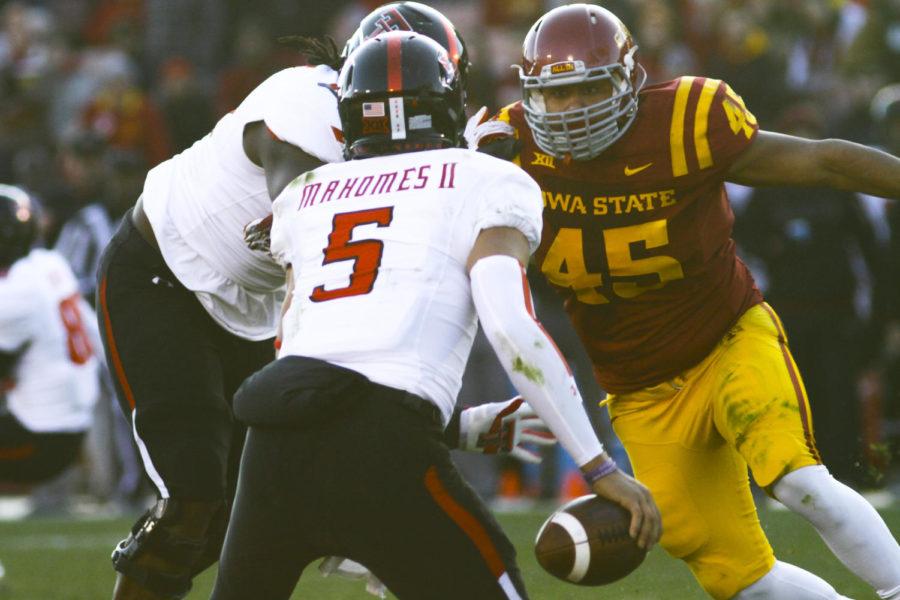Dale Pierson primed for production in senior season
Tiffany Herring/Iowa State Daily
Then-senior defensive end Dale Pierson goes after then-Texas Tech quarterback Patrick Mahomes on Nov. 22, 2014, at Jack Trice Stadium. Pierson and fellow defensive lineman Trent Taylor worked on leading other junior college transfers in their first season.
March 27, 2015
The ISU coaching staff is tackling a number of concerns during spring sessions, but replacing the graduated Cory Morrissey on the defensive line is at the top of that list.
The leading contender to take over Morrissey’s role as one of two starting defensive ends is Dale Pierson, who transferred from Pasadena Community College last season. However, ISU coach Paul Rhoads said that nothing is set in stone.
“[Pierson] was one of our leaders in the fourth quarter workouts and because of that, he elevated himself to a first-string position when we started,” Rhoads explained. “There’s probably as good of competition at end right now as anywhere on the field, and so [his] play continues to be elevated on top of what he did in the offseason.”
Rhoads said that Pierson isn’t the biggest or most physical defensive end in the collegiate game but added where Pierson’s advantage lies in his quickness and explosiveness. Pierson has leaned on those two traits to make himself the front-runner at a position that is three players deep on both sides.
Pierson came on toward the end of last season, his first as a Cyclone, having been hampered earlier in the year due in part to showing up on campus only a month before the first game. Primarily a pass rusher who set the edge in junior college, the responsibilities and discipline required of Pierson at Iowa State was a change that he said took some getting used to.
The desired results during a season of learning on the fly began to appear for Pierson against Kansas, where he said he first found his swagger. But early on, Pierson perceived his position with the team as far more precarious.
“I talked to [ISU defensive line coach Stan Eggen] after the [North Dakota State] game … and I asked him why I only got three plays, and he didn’t think I was ready,” Pierson said. “Maybe I wasn’t ready, but as he kept pushing me and kept pushing me, that just made me go harder in practice and ended up making me a better player.”
Pierson played in all 12 games last season, starting the final two. He ended the year with 29 tackles, including 4.5 for loss, which was tied for fourth on the team. Most of that production came in the final third of the season.
In his final four appearances, Pierson tallied 22.5 tackles, including 3.5 for loss, picked up two sacks and recovered two fumbles, as well as forced one fumble of his own.
“He started playing a little bit more, and I think it was confidence,” Eggen said. “You have to kind of feel comfortable with the position and then his confidence started coming along. Then, I think, you saw a different player.”
Pierson said that learning from Morrissey first-hand last season should help him with what he hopes will be a transition to the starting lineup on a permanent basis and a prominent leadership role with the Cyclones in his senior season.
“I want to be the best defensive end that’s ever come out of here,” Pierson said.







